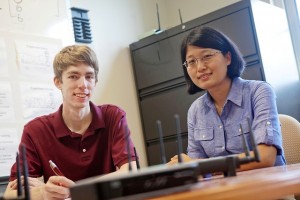In high school, John Keller ’14 (Orwigsburg, Pa.) taught himself how to program robots. His biggest achievement was tweaking a Roomba—a vacuum-cleaning robot—so that it could figure out where it was in a room and travel wherever it was told.

John Keller ’14 and Xiaoyan Li, assistant professor of computer science, are working to perfect a Wi-Fi system that detects the positions of people and objects inside a building.
A computer science major, Keller has since moved on to bigger tasks. This summer, he collaborated with Xiaoyan Li, assistant professor of computer science. The two worked to perfect a system that uses wireless networks, or Wi-Fi, to detect the positions of people and objects inside a building. In July, they presented a paper on their research at the Sixth International Workshop on Wireless Mesh and Ad Hoc Networks, which was part of the 21st International Conference on Computer Communications and Networks in Munich, Germany.
“John is a very good student,” says Li. “He’s smart, hard-working, and has good research potential.”
Li began working with Keller last summer, after she created an algorithm for using Wi-Fi to locate an object within a building. The object—such as a cell phone or a computer chip—must be Wi-Fi-enabled, and the algorithm works by using the strengths of available Wi-Fi signals to map the object’s position. Such technology could be useful for navigating an unfamiliar building, keeping track of important items, or even locating people (as long as they’re attached to their cell phones). Li’s first assignment for Keller: implement the algorithm on a cell phone so that the device would be able to detect its own position.
Keller accomplished this successfully, but hit a bit of a roadblock.
“It ran kind of slow, because cell phones aren’t as fast as computers,” he says. “So I changed the algorithm.”
The program ran dramatically faster. Their paper describes the ways in which the two continued to speed it up. At the conference, Keller saw many others working with wireless networking. A big part of the learning process, he says, was just discovering how to write and present technical papers. This will prove important if Keller continues his computer science education at graduate school, which he is considering.
One thing he knows for sure: He has enjoyed the independence of his research with Li.
“She’ll give you something to do,” he says, “but it’s up to you to figure out how to do it.”
Keller’s research was funded in part through the EXCEL Scholars undergraduate research program. EXCEL students earn a stipend while working one-on-one or in small groups with faculty. Many projects result in conference presentations and publication in peer-reviewed journals.

1 Comment
Bro you’re awesome
Comments are closed.